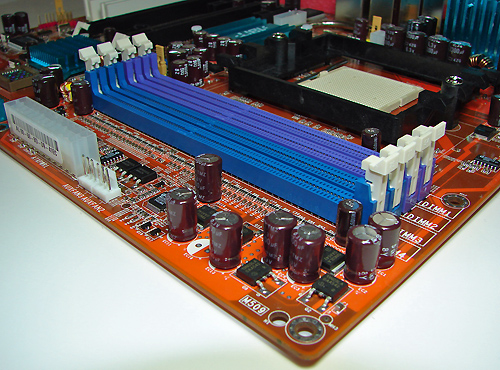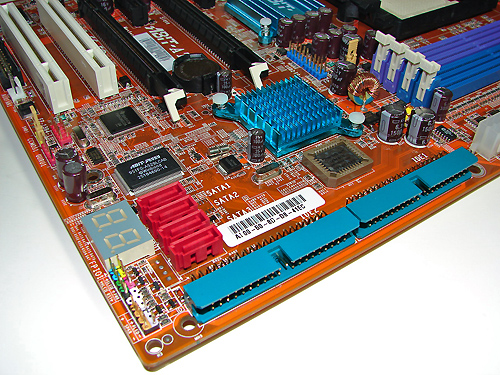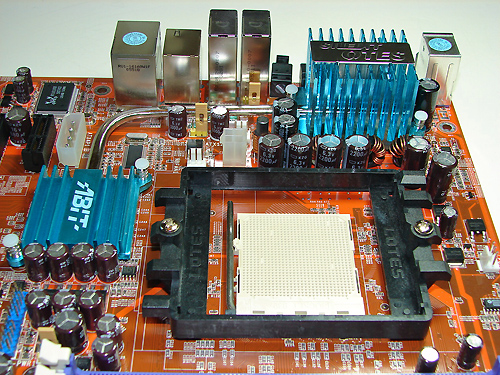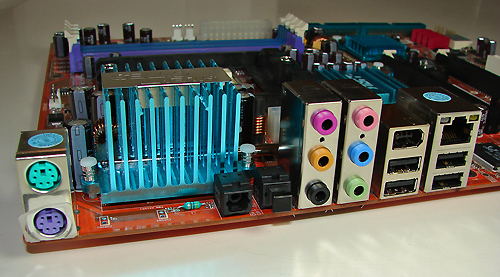Abit AT8: µGuru comes to the RD480
by Gary Key on March 10, 2006 12:05 AM EST- Posted in
- Motherboards
Abit AT8: Features
The ULi SATA ports are conveniently located above the number two IDE port connector and to the right of the CP80P post port debug LED. The SATA ports feature the new clamp and latch design, but are not color-coded. The chassis panel is located on the bottom left edge of the board below the CP80P LED. We do miss the power on and reset buttons from previous Abit boards.
The µGuru chipset is located above the ULi SATA ports and independently controls the µGuru functions . The TI TSB43AB22 IEEE 1394 chipset is located above the µGuru chipset. The IEEE 1394 connector is color-coded red and is located directly to the left of the TI IEEE 1394 chipset. The yellow clear CMOS jumper block is a traditional jumper design located to the left of the IEEE 1394 connector and along the edge of the motherboard. The red GURU connector is located below the CMOS jumper and also along the edge of the motherboard.
The first PCI Express x1 connector is located below the 4-pin power connector that must be used if two video cards are installed. The first physical PCI Express x16 connector is located next, followed by the second PCI Express x1 connector, second PCI Express x16 connector, and the two PCI 2.3 slots. The floppy drive connector is located below the second PCI slot and is inconveniently located for most case designs. The third of six fan headers located on the board is located to the right of the floppy drive connector.
We did not have any issues installing our ATI X1900XT video cards in the first and second x16 PCI Express slots. These dual slot configuration cards will physically render the second PCI Express x1 and first 32-bit PCI slot useless. We did not have any issues utilizing these slots with video cards containing single slot cooling systems. The first PCI Express x16 connector is considered to be the secondary slot and the second PCI Express x16 connector is considered to be the primary slot. If you utilize one video card, it must be installed in the primary slot. Abit ships a shadow card to use in the secondary slot in single video card configurations, but we found that it was not necessary to use the card. When we installed our EVGA 7800GTX 512MB card in the primary slot, it blocked the first three SATA ports.
The ATI Crossfire Xpress 200 chipset is passively cooled with a small heat sink unit that did not interfere with any installed peripherals. This unit along with the heatpipe running to the large PVM heat sink kept the chipsets cooled well during overclock testing.
Abit places the ATX12V auxiliary power connector at the top of the CPU socket area. This connector is located in an unusual position and could hamper airflow with cabling that crosses directly over the CPU heat sink/fan; although, we did not have any issues in our case.



The ULi SATA ports are conveniently located above the number two IDE port connector and to the right of the CP80P post port debug LED. The SATA ports feature the new clamp and latch design, but are not color-coded. The chassis panel is located on the bottom left edge of the board below the CP80P LED. We do miss the power on and reset buttons from previous Abit boards.
The µGuru chipset is located above the ULi SATA ports and independently controls the µGuru functions . The TI TSB43AB22 IEEE 1394 chipset is located above the µGuru chipset. The IEEE 1394 connector is color-coded red and is located directly to the left of the TI IEEE 1394 chipset. The yellow clear CMOS jumper block is a traditional jumper design located to the left of the IEEE 1394 connector and along the edge of the motherboard. The red GURU connector is located below the CMOS jumper and also along the edge of the motherboard.

The first PCI Express x1 connector is located below the 4-pin power connector that must be used if two video cards are installed. The first physical PCI Express x16 connector is located next, followed by the second PCI Express x1 connector, second PCI Express x16 connector, and the two PCI 2.3 slots. The floppy drive connector is located below the second PCI slot and is inconveniently located for most case designs. The third of six fan headers located on the board is located to the right of the floppy drive connector.
We did not have any issues installing our ATI X1900XT video cards in the first and second x16 PCI Express slots. These dual slot configuration cards will physically render the second PCI Express x1 and first 32-bit PCI slot useless. We did not have any issues utilizing these slots with video cards containing single slot cooling systems. The first PCI Express x16 connector is considered to be the secondary slot and the second PCI Express x16 connector is considered to be the primary slot. If you utilize one video card, it must be installed in the primary slot. Abit ships a shadow card to use in the secondary slot in single video card configurations, but we found that it was not necessary to use the card. When we installed our EVGA 7800GTX 512MB card in the primary slot, it blocked the first three SATA ports.


The ATI Crossfire Xpress 200 chipset is passively cooled with a small heat sink unit that did not interfere with any installed peripherals. This unit along with the heatpipe running to the large PVM heat sink kept the chipsets cooled well during overclock testing.
Abit places the ATX12V auxiliary power connector at the top of the CPU socket area. This connector is located in an unusual position and could hamper airflow with cabling that crosses directly over the CPU heat sink/fan; although, we did not have any issues in our case.











42 Comments
View All Comments
Duplex - Tuesday, March 21, 2006 - link
I really liked it you did a test with BH5 at 1T 2225 timings,BUT,
I would be so much happier if you also could test at how high clocks you
can run at 1T 2225-timings. That is at least how I define overclocking memory.
You still have the board, so pleeeaaaaaaaaaaase give it a try!
You overclocked with 1T 2.5-5-5-7 timings, but as I´m sure you know it´s not the same thing as overclocking the memory with 1T-2-2-2-5 timings, which BH5/UTT owners mainly gain performance from.
This is something I miss with most of your reviews, and I think Many Many readers would appreciate if you both tryed overclocking with tight resp. lose timings in the future.
It´s often tight timings that makes the boards stand out from the rest.
CPU stability and overclocking seldom differs more than 10% while the RAM clocks at 1T-2-2-2-5 often is either 200MHz or something like 280MHz (40%). Many boards still can´t run 1T-2-2-2-5 at all.
Memory Performance is about 1. tight timings and 2. high clocks
Maybe my facts isn´t totally correct, but I hope you see what I´m aiming at :-)
Gary Key - Friday, March 24, 2006 - link
Hi,
We are currently testing another RD480 board so I will provide the highest stable overclock at 2-2-2-5(7)-1T for the Abit and Asus RD480 boards along with the new one.
Gary
Duplex - Friday, March 24, 2006 - link
Great! Splendido! Magnifico! eeeeh, Excellent! Much appreciated!Duplex - Wednesday, April 5, 2006 - link
How are things going with the revised 1.1 bios, is the 256HTT limit gone?Has there been any time to look into it? ;-)
I read the ECS-review. Nice to see the
"The ECS KA1 MVP was very stable with 2 DDR modules in Dual-Channel mode at the settings of 2-2-2-5 at 2.7v. We were able to operate the memory at this configuration up to a 226HTT x12 setting." !!
Whats happening with the tests you mentioned above with the Asus and Abit board?
Estimated publishing date?
FireTech - Friday, March 17, 2006 - link
Agreed, love the look of this MB for it's passive cooling and fan control options. I'll have to wait for the AT8 32X though as the AT8 is now discontinued here.Any news on the BIOS #1.1 results?
Gary Key - Monday, March 20, 2006 - link
So far so good. We are waiting on a particular GSkill module to arrive to complete testing.
SpHeRe31459 - Saturday, March 11, 2006 - link
Dolby Digital Live is an option that a vendor must persue with Dolby and get their motherboard certified. Abit has not shown interest in this before, nothing I can find at the Abit site says this is Dolby Digital Live enabled. You guys sure about the AT8 having DDL?Gary Key - Saturday, March 11, 2006 - link
http://www.abit.com.tw/page/en/motherboard/motherb...">AT8 SpecsThe audio specifications are listed on the global site. The US site has the AL8 specs on the webpage and Abit has been notified of this. Abit is now including the ALC-882D with the DDL option on their higher end boards. We did not see it as being offered originally on the AT8-32x (complained about it) but have been told it will be included now. In fact, their Global website has been updated and shows it on the board. The board I tested had the ALC-882D codec and DDL (5.1, optical out to supporting receiver) was enabled in the drivers I used.
cornfedone - Friday, March 10, 2006 - link
Looks like Abit, even though late to market, didn't bother testing their ATI chipset mobo before shipping it either. They must have figured if Asus could sell the completely junk A8R-MVP garbage, then there were plenty of fools who would rush out and buy the Abit version of garbage. You got to believe that judgment day isn't too far off for the Asian mobo companies if they keep shipping this kind of junk.It's pretty obvious Asus needs to switch product lines from PC hardware to rice cakes or chop suey so their skill set matches their products.
rjm55 - Saturday, March 11, 2006 - link
Looks like the paid nVidia forum posters are at it again. They must really be afraid of ATI chipsets to go to these extremes. Wonder why?It's a shame this decent review got hijacked by a few crazies whose only goal was to disrupt and discredit.